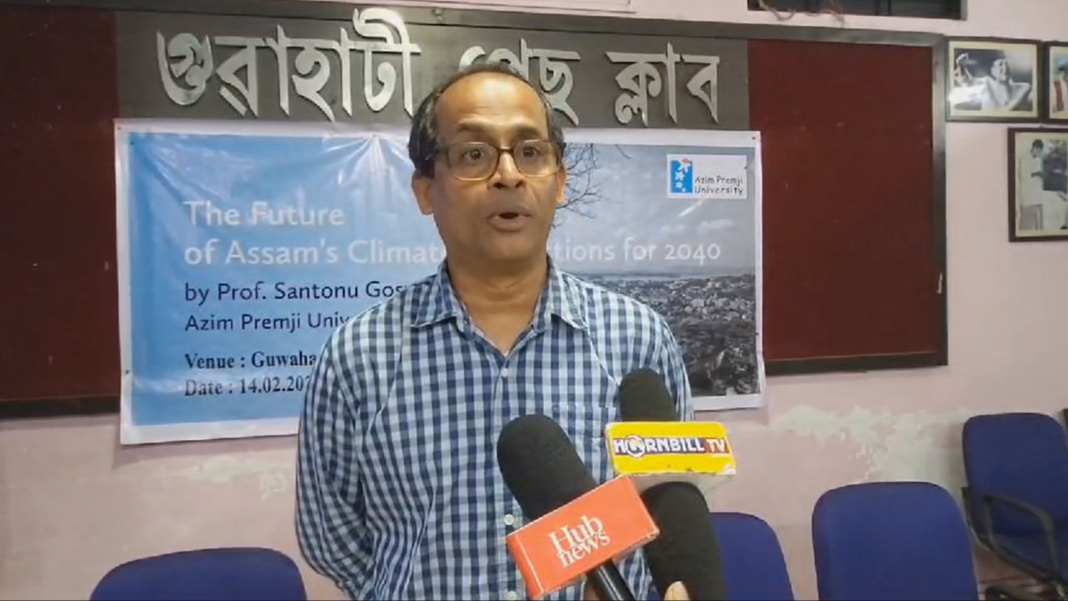Guwahati, Feb 15: Assam’s climate is set for a dramatic transformation by 2040, with rising temperatures, shifting rainfall patterns, and escalating heat risks threatening the state’s economy, ecosystems, and public health.
Speaking at the Guwahati Press Club on Friday, Dr. Santonu Goswami, a professor at Azim Premji University, Bengaluru, laid out the alarming projections based on the medium-emission SSP 2-4.5 scenario.
Scorching Summers and Warmer Winters
The data suggests Assam will face a steady rise in temperatures across all districts, with Tinsukia, Dhemaji, and Dibrugarh expected to bear the brunt. These regions will see their annual maximum temperatures rise by 0.83°C, 0.76°C, and 0.74°C, respectively. Summer heatwaves will intensify, pushing already high temperatures even further.
But it’s not just the summers—Assam’s winters are also set to become significantly warmer. South Salmara-Mankachar, Jorhat, and Chirang will experience winter maximum temperature increases of 1.6°C, 1.46°C, and 1.4°C, respectively. This shift could have profound consequences for agriculture, biodiversity, and the state’s energy needs.
Rising Heat Stress and Health Risks
As temperatures climb, wet bulb temperatures—a measure of heat and humidity—will also soar, raising serious health concerns. Jorhat and Majuli are predicted to exceed 31°C, a dangerous threshold for human endurance during heatwaves. Nagaon is expected to witness a 1.95°C rise in its annual wet bulb temperature, making heat-related illnesses and fatalities more likely.

Erratic Rainfall: Droughts and Deluges
Assam’s monsoons will become increasingly unpredictable, bringing both prolonged dry spells and extreme downpours.
South Salmara-Mankachar could face up to 13.7 consecutive dry days during the Southwest monsoon, while the Northeast monsoon may stretch dry spells to a staggering 68.12 days.
At the same time, South Salmara-Mankachar may endure 46.88 days of very heavy rainfall in the Southwest monsoon, while Hojai could see an 11.08% drop in such days during the Northeast monsoon.
These erratic shifts could spell disaster for Assam’s agrarian economy, leading to water shortages, unpredictable crop cycles, and an increased risk of floods and droughts.
A Wake-Up Call for Climate Action
Dr. Goswami emphasized that, for the first time in India, district-level climate projections are now publicly accessible, allowing policymakers, researchers, and citizens to download climate data for any district in the country. He urged Assam’s government to use this resource for proactive disaster management and climate adaptation strategies.
“The rising temperatures, increasing wet bulb stress, and shifting rainfall patterns pose serious risks. If we act now, we can prepare for these challenges. This data should serve as a tool for informed planning and immediate action,” Dr. Goswami said.
Read: Mixed reactions in Manipur as President’s Rule sparks tension and hope
WATCH:
Find latest news from every corner of Northeast India at hubnetwork.in, your online source for breaking news, video coverage.
Also, Follow us on-
Twitter-twitter.com/nemediahub
Youtube channel- www.youtube.com/@NortheastMediaHub2020
Instagram- www.instagram.com/ne_media_hub
Download our app from playstore – Northeast Media Hub





